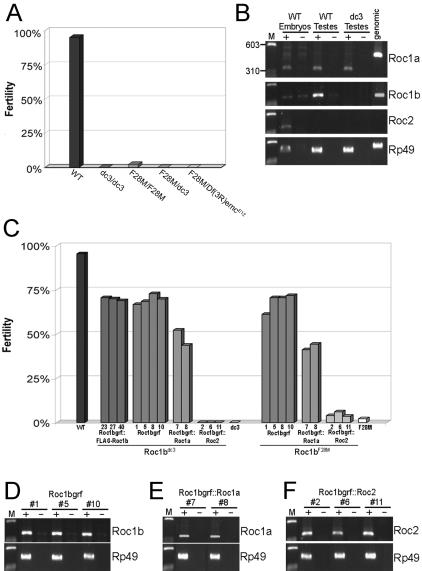Figure 5.
The Roc1b mutation causes male sterility. (A) Graph showing fertility of wild-type and various Roc1b mutant males. “Fertility” is the percentage of viable progeny produced by 30 males mated individually to three virgin females. (B) RT-PCR performed on indicated tissues using primer sets designated on the right. Genomic DNA was used as a control for each primer set. + and - indicate reactions with or without reverse transcriptase. The Roc1a and Rp49 primer sets span small introns and thus produce slightly larger PCR fragments. The Roc2 primer set spans a 26-kb intron. WT embryos were also used as a control to test primer sets that do not amplify messages in the testes (i.e., Roc2). This also reaffirms our previous observation that each Roc is expressed in the embryo (Noureddine et al., 2002). Roc1b does not contain an intron and the primers amplify a band in the no-RT control, indicating the presence of some contaminating DNA. Both Roc1a and Roc1b are expressed in the testis, but Roc2 is not. Note the absence of Roc1b message in the Roc1bdc3 mutant. M indicates Marker and is the same in other panels. (C) Expression of FLAG-Roc1b, Roc1b, and Roc1a, but not Roc2, can rescue the male sterile phenotype. Roc transgenes expressed with the Roc1b promoter were crossed into the Roc1bdc3 (null, left) or Roc1bF28M (hypomorph, right) backgrounds and the percentage of viable progeny from individual males was determined. Three transgenic lines expressing FLAG-Roc1b (#23, #27, and #40) and four lines expressing native Roc1b (#1, #5, #8, and #10) were found to rescue the mutations. Two transgenic lines expressing Roc1a (#7 and #8) also rescue the mutations, but to a significantly lower degree (see Table 2). None of three Roc2 transgenic lines (#2, #6, and #11) showed any significant rescue. (D-F) RT-PCR of testes from Roc1bdc3 mutant males expressing a Roc1bgrf transgene. Three of the four individual Roc1b lines (D), both Roc1a lines (E), and all three Roc2 lines (F) used in the rescue assay were tested, and each indicates a similar level of expression.

